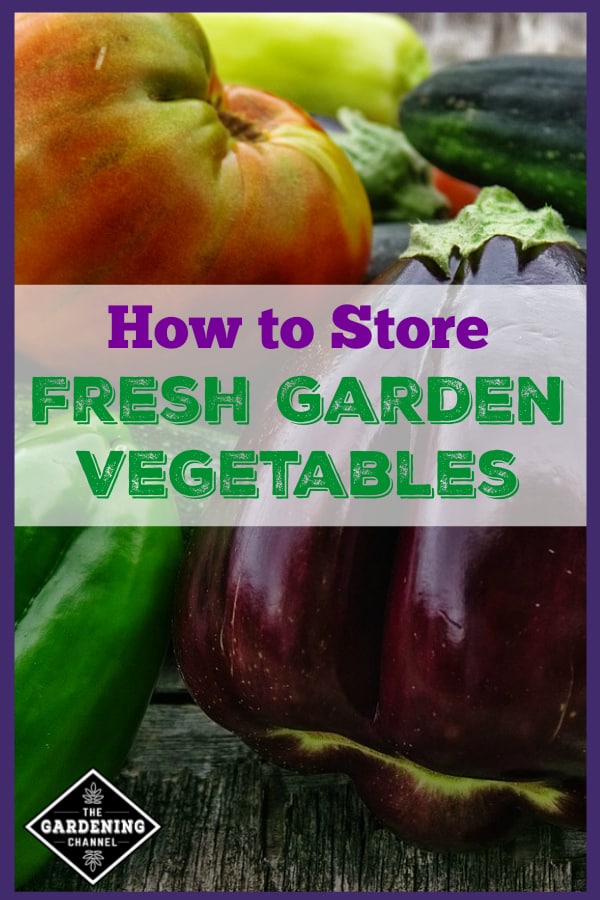How To Store Fresh Vegetables From The Garden

The harvest is payoff time for the gardener and farmer. It's when all the work comes to fruition. The most intensive time in a gardener's season, however, is just beginning when harvest comes. Bringing in the garden's bounty and storing it takes a a lot of work.
Tips for Managing Garden Produce
Best practices for storing produce, but for the short and longterm, will ensure minimal losses during this hectic time of year. Properly packing, storing, and managing your harvest will mean an abundance of good food for a long time. Check out these tips below on how to preserve your harvest. Make sure you use safe practices for food storage in your kitchen. There's a link at the bottom of the article for more information with special attention to the crop that is being preserved.
Storing Fresh Vegetables
Taking care of your vegetables from picking to storing is all about doing the job right so your efforts in growing that great bounty aren't wasted. Clean and dry all vegetables carefully, being sure not to break the skin with scrubbing or scraping. Use clean water (no soap) and wipe away the dirt. Then lay out to dry on towels or blankets.
Proper Refrigeration
Most intact (uncut) vegetables can be refrigerated as they are. Filling crisper or salad drawers or bowls put onto refrigerator shelves is enough. Some leafy greens like lettuce and spinach should be stored in cloth bags that can be closed. Most vegetables will do well in refrigeration for a week or so. The longer they are in there, however, the more nutrients they'll potentially lose, so your longer-term plans for storage should be quickly underway.
Packing Fresh Vegetables
Some vegetables can be packed and stored for a long time without anything more than a temperature-controlled area. Until recently, it was common to clutch root vegetables like potatoes at the center of mounds of dirt, which insulated them through the harshest weather.
Today, most people store their potatoes, thick-skinned squash, onions, etc. in root cellars or cool, dry larders. Some veggies need specific care to be stored this way, but so long as the temperature is held at 60-65 degrees Fahrenheit (for most), they will store for several months and stay fresh.
Root cellar and similar stored vegetables should be packed carefully to avoid bruising and should not be so deeply or heavily packed that their own weight crushes them.
Freezing Fresh Vegetables
Storing vegetables ready-to-use in the freezer is another popular method for long-term storage. The vegetables are usually prepared (green beans cut, spinach boiled, etc.) and blanched (quickly boiled and then cooled under water) to make them easier to use when the time comes, to lessen their volume for storage, and to eliminate microbes that could cause spoilage.
Vegetables to be frozen should be flash frozen if possible. Turn the freezer down to -10 degrees Farenheit a day or two before processing your vegetables and leave it that way until a day or two after the vegetables have been put in for freezing. Avoid overloading your freezer by putting too many unfrozen vegetables into it at one time.
Most people prefer freezer bags or stacked, sealed containers. Bags should be flattened and drained of air before sealing. Both types of container should be clearly labeled with the vegetable type and the date of freezing.
Canning Fresh Vegetables
The time-honored method of canning or jarring vegetables is another great way to preserve the harvest for the long-term. Of all the methods listed here, this one will last the longest (usually 2 or more years for most veggies, many much longer).
Canning is simply preparing the vegetables for the jar, adding water and (possibly) a preservative like vinegar or lemon oil, and boiling to both remove contaminates and cause the jar to seal when it returns to room temperature.
This can be a fun, family activity and requires only inexpensive tools to accomplish. It is, however, fairly labor intensive compared to other methods already listed.
Succession Planting To Manage Harvest Times
The easiest way to deal with a relatively large garden is to plant successively. This means planting vegetables in such a way to as time their harvest so that they can be picked over time rather than all at once.
This way, beets and carrots will be ready at the same time, but tomatoes and beans won't be harvested until a week or two later. This can spread the harvest over a month or even six weeks, saving a lot of hectic effort for the gardener.
Want to learn more about storing fresh garden vegetables?
Check out:
Guide to Storing Fresh Vegetables from University of Idaho Extension

How To Store Fresh Vegetables From The Garden
Source: https://www.gardeningchannel.com/storing-fresh-garden-vegetables/
Posted by: nolandrowend.blogspot.com

0 Response to "How To Store Fresh Vegetables From The Garden"
Post a Comment